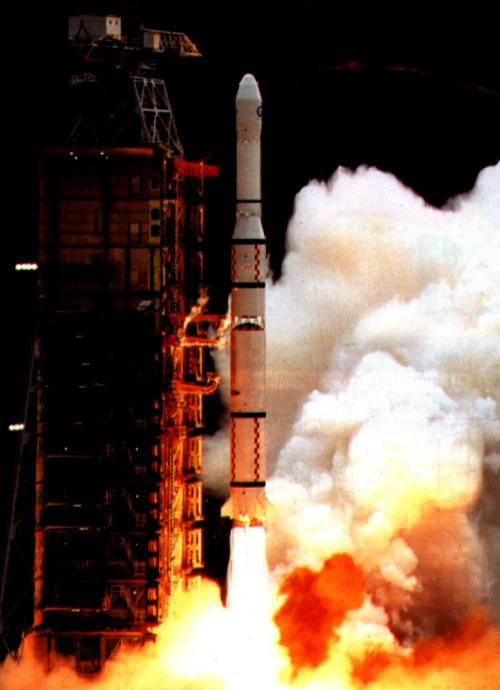
Long March 3
In-activeChina Aerospace Science and Technology Corporation (CASC)
Jan. 29, 1984
Description
The Long March 3 is a chinese orbital carrier rocket. They all launched from Launch Area 3 at the Xichang Satellite Launch Center. It is a 3 stage rocket used to put communication satellites into geosynchronous trasfer orbits.
Specifications
-
Stages
3 -
Length
23.49 m -
Diameter
3.35 m -
Fairing Diameter
3.35 m -
Launch Mass
204.0 T -
Thrust
2961.0 kN
Family
-
Name
Long March 3 -
Family
― -
Variant
― -
Alias
― -
Full Name
Long March 3
Payload Capacity
-
Launch Cost
― -
Low Earth Orbit
5000.0 kg -
Geostationary Transfer
Orbit
1500.0 kg -
Direct Geostationary
― -
Sun-Synchronous Capacity
―
China Aerospace Science and Technology Corporation
Government
Chairman & President: Lei Fanpei
CASC 1999The China Aerospace Science and Technology Corporation (CASC) is the main contractor for the Chinese space program. It is state-owned and has a number of subordinate entities which design, develop and manufacture a range of spacecraft, launch vehicles, strategic and tactical missile systems, and ground equipment. It was officially established in July 1999 as part of a Chinese government reform drive, having previously been one part of the former China Aerospace Corporation. Various incarnations of the program date back to 1956.
Long March 3 | Feng Yun 2B
China Aerospace Science and Technology Corporation | ChinaXichang Satellite Launch Center, People's Republic of China
June 25, 2000, 11:50 a.m.
Long March 3 | Feng Yun 2A
China Aerospace Science and Technology Corporation | ChinaXichang Satellite Launch Center, People's Republic of China
June 10, 1997, 12:01 p.m.
Long March 3 | Zhongxing 7
China Aerospace Science and Technology Corporation | ChinaXichang Satellite Launch Center, People's Republic of China
Aug. 18, 1996, 10:27 a.m.
Status: Launch Failure
Mission:
ChinaSat 7 or ZX 7 (Zhongxing 7) is a Hughes HS-376 model geostationary telecommunications satellite built for the China Telecommunications Broadcast Satellite Corporation (ChinaSat). It was the first satellite ChinaSat had ordered from a western spacecraft contractor, Hughes Space and Communications International, Inc., known today as Boeing Satellite Systems International, Inc.
Geostationary OrbitLong March 3 | Apstar 1A
China Aerospace Science and Technology Corporation | ChinaXichang Satellite Launch Center, People's Republic of China
July 3, 1996, 10:47 a.m.
Status: Launch Successful
Mission:
The APSTAR 1 spacecraft carries such general communications traffic as voice, fax, data, and television signals across China and Hong Kong, Indonesia, Japan, Singapore, and Vietnam. APSTAR 1A has expanded coverage to India and Pakistan. Hughes Space and Communications International, Inc., signed a contract in May 1992 with APT Satellite Company, Ltd., of Hong Kong for the first satellite. APT ordered APSTAR IA in March 1995. The spacecraft were built at the Hughes Space and Communications Company facilities in El Segundo, Calif.
Geostationary OrbitLong March 3 | APSTAR 1
China Aerospace Science and Technology Corporation | ChinaXichang Satellite Launch Center, People's Republic of China
July 21, 1994, 10:55 a.m.
Status: Launch Successful
Mission:
The APSTAR 1 spacecraft carries such general communications traffic as voice, fax, data, and television signals across China and Hong Kong, Indonesia, Japan, Singapore, and Vietnam. APSTAR 1A has expanded coverage to India and Pakistan. Hughes Space and Communications International, Inc., signed a contract in May 1992 with APT Satellite Company, Ltd., of Hong Kong for the first satellite. APT ordered APSTAR IA in March 1995. The spacecraft were built at the Hughes Space and Communications Company facilities in El Segundo, Calif.
Geostationary OrbitLong March 3 | DFH-2A 5
China Aerospace Science and Technology Corporation | ChinaXichang Satellite Launch Center, People's Republic of China
Dec. 28, 1991, noon
Long March 3 | Asiasat 1
China Aerospace Science and Technology Corporation | ChinaXichang Satellite Launch Center, People's Republic of China
April 7, 1990, 1:30 p.m.
Long March 3 | DFH-2A 4
China Aerospace Science and Technology Corporation | ChinaXichang Satellite Launch Center, People's Republic of China
Feb. 4, 1990, 12:27 p.m.
Long March 3 | DFH-2A 3
China Aerospace Science and Technology Corporation | ChinaXichang Satellite Launch Center, People's Republic of China
Dec. 22, 1988, 12:40 p.m.
Long March 3 | DFH-2A 2
China Aerospace Science and Technology Corporation | ChinaXichang Satellite Launch Center, People's Republic of China
March 7, 1988, 12:41 p.m.
Long March 3 | DFH-2A 1
China Aerospace Science and Technology Corporation | ChinaXichang Satellite Launch Center, People's Republic of China
Feb. 1, 1986, 12:37 p.m.
Long March 3 | DFH-2 2
China Aerospace Science and Technology Corporation | ChinaXichang Satellite Launch Center, People's Republic of China
April 8, 1984, 11:20 a.m.
Electron
Don't Be Such A Square (STP-S30)
Rocket Lab Launch Complex 2 (Launch Area 0 C) - Wallops Flight Facility, Virginia, USASTP-S30 is a complex mission that will deliver research experiments and technology demonstrations to orbit for the DoD and contribute to future space…
Falcon 9
Starlink Group 15-13
Space Launch Complex 4E - Vandenberg SFB, CA, USAA batch of 27 satellites for the Starlink mega-constellation - SpaceX's project for space-based Internet communication system.
Falcon 9
Starlink Group 6-99
Launch Complex 39A - Kennedy Space Center, FL, USAA batch of 29 satellites for the Starlink mega-constellation - SpaceX's project for space-based Internet communication system.
Ariane 62
Galileo L14 (FOC FM33 & FM34)
Ariane Launch Area 4 - Guiana Space Centre, French GuianaPayload consists of two satellites for Europe's Galileo navigation system.
Atlas V 551
Amazon Leo (LA-04)
Space Launch Complex 41 - Cape Canaveral SFS, FL, USAAmazon Leo, formerly known as Project Kuiper, is a mega constellation of satellites in Low Earth Orbit that will offer broadband internet access, thi…

